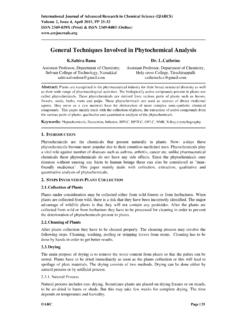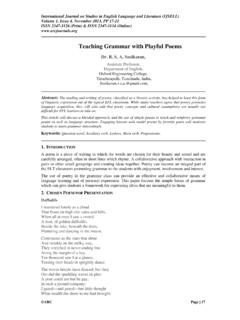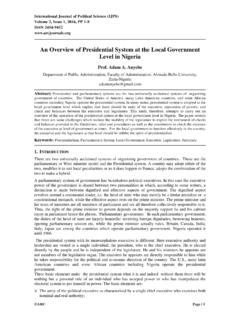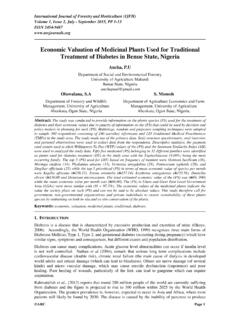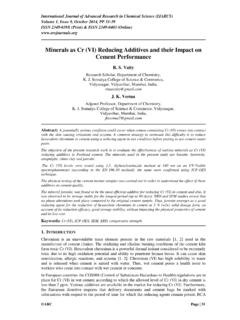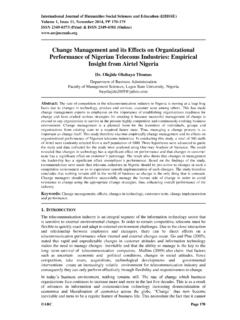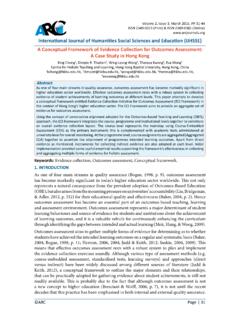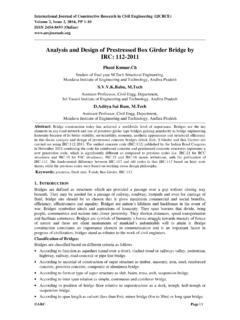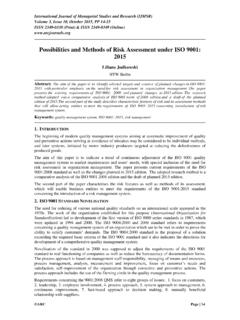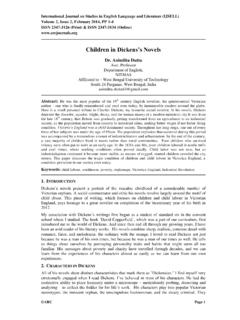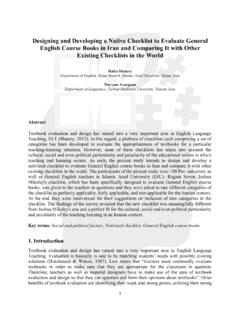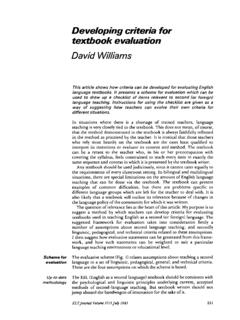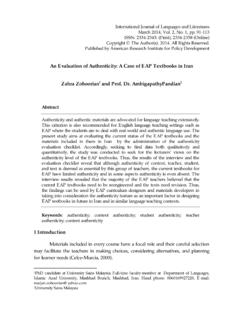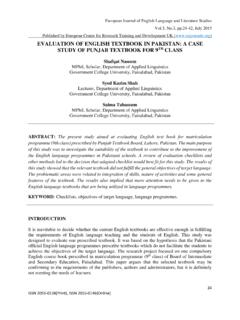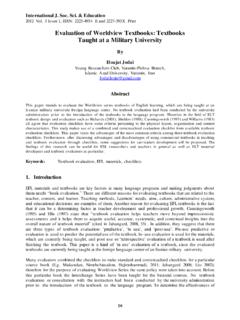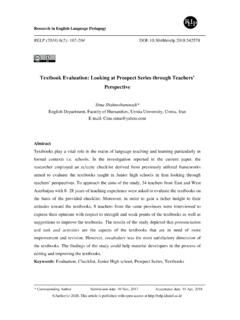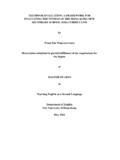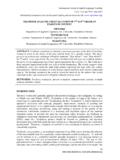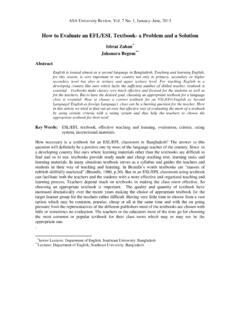Transcription of Textbook Evaluation: An Investigation into “American ...
1 International Journal on Studies in English Language and Literature (IJSELL) Textbook evaluation : An Investigation into american English File SeriesSeyede Zahra Hashemi, of Foreign Languages, Shiraz Branch, Islamic Azad University, Shiraz, Iran. Email: Borhani, of Foreign Languages, Shiraz Branch, Islamic Azad University, Shiraz, Iran Email: 3, Issue 5, May 2015, PP 47-55 ISSN 2347-3126 (Print) & ISSN 2347-3134 (Online) ARC Page | 47 AbstractELT materials (textbooks) play a really crucial role in many language classrooms, but in recent years there has been a lot of debate throughout the ELT profession on the actual role of materials in teaching English as a Second/Foreign Language (TESL/TEFL).
2 Some issues that have been discussed in recent years include text-book design and practicality, methodological validity, the role of textbooks in innovation, the authenticity of materials in terms of their representation of language, and the appropriateness of gender representation, subject matter, and cultural components. This study aims at an Investigation into american English File series in Iran EFL context. To this end, twenty-three experienced teachers holding degree from to and age range 24-37 were called for cooperation. A forty item questionnaire adapted from David Litz (2000) was used to elicit information needed for the study. The data obtained through the questionnaire were then subject to descriptiveand inferential statistics.
3 Results indicated that american English File series was a suitable and appropriate device for language teachers to obtain their aims as well as the aims of the language : evaluation , ELT Materials, TESL, Practicality, Methodological Validity, Authenticity, Independent Sample T-testINTRODUCTIONA very important professional activity for all EFL teachers is the ability to evaluate teaching materials effectively. Today there is a wealth of EFL materials available, with hundreds of new, commercially available titles appearing every year. Teachers or course organizers are often under considerable professional and financial pressure to select a course book for an ELT program that will then become the Textbook for years to come.
4 Moreover, materials are usually seen as being the core of a particular program and are the most visible representation of what happens in the classroom. O Neill (1982) states that No other medium is as easy to use as a book ( ).The evaluation of current materials, therefore, deserves serious consideration since an inappropriate choice may waste funds and time and has a demotivating effect on students and possibly teachers. Another reason for Textbook evaluation is the fact that it can be very useful in teacher development and professional growth. Cunningsworth (1995) and Ellis (1997) believe that Textbook evaluation helps teachers move beyond impressionistic assessments and helps them to get useful, accurate, systematic, and contextual insights into the overall nature of Textbook material.
5 Textbook evaluation can also be a valuable part of teacher training programs since it serves the purpose of making teachers aware of important features to look for in textbooks while familiarizing them with a wide range of published language instruction Textbook or set of materials is likely to be perfect. What is more, according to Sheldon (1988) coursebook assessment is fundamentally a subjective, rule-of-thumb actively and there exists no neat formula or system to provide a definite yardstick ( ). Nevertheless, there is a need for a model that s brief, practical to use and comprehensive in its coverage of criteria. As Cunningsworth (1995) notes, it is important to limit the number of criteria used and the number of questions asked to manageable proportions ( ).
6 Otherwise, we risk being swamped in a sea of detail. Tomlinson (1999) also suggests that the obvious but important point is that International Journal on Studies in English Language and Literature (IJSELL) Page | 48 Seyede Zahra Hashemi, and Amin Borhani, can be no one model framework for the evaluation of materials; the framework used must be determined by the reasons, objectives, and circumstances of the evaluation ( ).A. The Role of Textbooks in EFL / ESL ClassroomsTextbooks play a very crucial role in language teaching and learning and are considered to be the second important factor in the second / foreign language classroom compared to the teacher.
7 As Hutchinson and Torres (1994) suggest:The Textbook is an almost universal element of [English language] teaching. Millions of copies are sold every year, and numerous aid projects have been set up to produce them in [various] teaching-learning situation, it seems, is complete until it has its relevant Textbook ( ).Haycroft (1998) suggests that one of the primary advantages of using textbooks is that they are psychologically essential for students since their progress and achievement can be measured concretely when we use them. Sheldon (1988) has stated, students often have expectations about using a Textbook in their particular language classroom and program and believe that published materials have more credibility than teacher-generated or in-house materials.
8 O Neill (1982) has indicated, textbooks are sensitive to students needs, even if they are not made specifically for them, they are efficient in terms of time and money, and they should allow for adaptation and improvisation. Another advantage identified by Cunningsworth (1995) is the potential which textbooks have for serving several additional roles in the ELT curriculum. He argues that they are an effective source for self-directed learning, an effective resource for presentation material, a source of ideas and activities, a reference source for students, a syllabus where they reflect pre-determined learning objectives, and support for less experienced teachers who have yet to gain in confidence. Hutchinson and Torres (1994) have pointed out that textbooks play a central role in innovation.
9 They suggest that textbooks can support teachers by potentially disturbing and threatening change processes; moreover, they demonstrate new and/or untried methodologies, introduce change gradually, and create scaffolding upon which teachers can build a more creative methodology of their take on a very important role in language classes, and it s important to select a good Textbook . This study seeks to evaluate new american English File series from the teacher s viewpoint and to see how appropriate and useful they are in order to meet the needs of students and to get a good feedback in terms of their instructional philosophy, approach, method, and technique which suits the students and their Review of LiteratureTextbooks in ELT are of crucial importance.
10 They must be of a suitable level of quality, usefulness, and appropriateness for the context and people with whom they are being used. While the literature on Textbook evaluation is not particularly extensive, various writers have presented evaluation checklists based on supposedly generalizable criteria that can be used by both teachers and students in many different situations. Although Sheldon (1988) states that no general list of criteria can really be applied to all teaching and learning contexts without considerable modification, many of these standardized evaluation checklists contain same components that can be used as helpful starting points for ELT practitioners in different situations.
